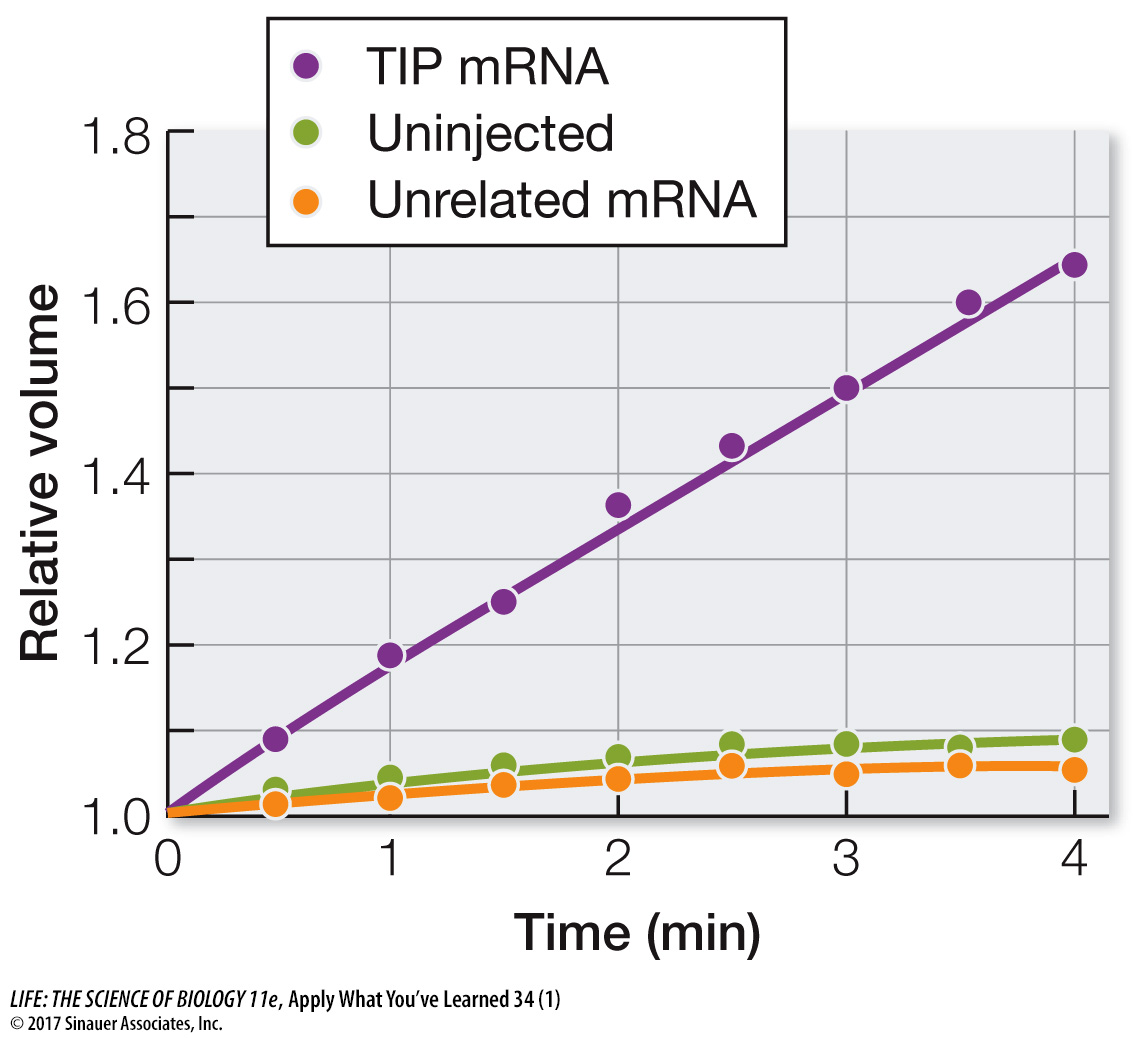Apply What You’ve Learned
Review
34.1
Water potential is determined by solute potential and pressure potential.
34.1
Movement of water and ions across a cell membrane can be impeded.
34.1
The two main pathways to get water from the soil into the xylem are the apoplast and the symplast.
Original Paper: Maurel, C., J. Reizer, J. I. Schroeder and M. J. Chrispeels. 1993. The vacuolar membrane protein γ-TIP creates water specific channels in Xenopus oocytes. The EMBO Journal 12: 2241−2247.
Most plant cells contain a large vacuole. In addition to the cell membrane, the vacuolar membrane (tonoplast) plays an important role in water relations between a plant cell and its environment. Changes in water potential in the environment can lead to changes in turgor pressure and therefore plant structure (see Key Concept 6.3 and Figure 6.10). The tonoplast contains a prominent protein called TIP (tonoplast intrinsic protein), which is related in sequence to the aquaporins of animal and bacterial cells.
Researchers investigated the possible aquaporin function of a tonoplast TIP from Arabidopsis thaliana by isolating the gene for the protein and expressing its mRNA in oocytes of the frog Xenopus laevis. These cells are large, and their size is easily measured in the light microscope. The oocyte cell membrane normally has low osmotic permeability. The researchers injected oocytes with the mRNA of the plant TIP, which contained the 5′ and 3′ untranslated sequences for protein synthesis in Xenopus. They injected other oocytes with an mRNA of a nontransport protein, and left yet other oocytes uninjected.
After injection, all of the oocytes were incubated in isotonic medium for 2 days to allow for protein synthesis and transport. Then the oocytes were placed in hypotonic medium to increase external water potential relative to the inside of the cells. The sizes of the oocytes were measured microscopically over 4 minutes and then compared. The results are shown in the graph.

After 4 minutes in hypotonic medium, the oocytes containing TIP mRNA burst; those injected with unrelated mRNA and those that were uninjected did not burst.
The researchers then calculated the osmotic water permeability of the oocyte cell membranes during the experiment. Osmotic permeability coefficient was measured from the change in volume and surface area of the cells and water potentials inside and outside the cells. A higher osmotic coefficient indicates greater water movement across the membrane. The results are shown in the table below.
| Condition | Osmotic water permeability (10–2 cm/sec) |
|---|---|
| TIP mRNA injected | 1.25 |
| Unrelated mRNA injected | 0.15 |
| Uninjected | 0.15 |
Questions
1.
From the graph, what can you conclude about the possible role of TIP? Why were the other two conditions important to your interpretation?
The increase in cell volume indicated that TIP may increase water permeability of the cell membrane and is therefore an aquaporin. The unrelated mRNA condition showed no increased cell volume, so the volume increase was not just due to any mRNA. The uninjected cells were controls to show that there was no natural increase when cells were placed in an environment that had increased water potential relative to the cell interior. This confirms low osmotic permeability of the frog oocytes.
2.
Why did the TIP-
The oocytes burst because there was a continuing uptake of water due to the plant aquaporin. No, plant cells injected with TIP mRNA would not have burst. In plant cells, the cell wall exerts turgor pressure potential that stops the cell from bursting.
3.
How do the data in the table relate to those in the figure?
The table shows direct measurements of increased osmotic water permeability in oocytes injected with TIP mRNA. This indicates that the increase in size shown in the figure, due to the presence of TIP in the oocyte membrane, was due to increased water flow, and in this case water flowed into the cell because the oocytes were in an environment of higher water potential (hypotonic).
4.
Since the original discovery of the first plant aquaporin TIP, numerous related proteins have been found in plants. Some are in the cell membrane (plasma intrinsic proteins, or PIPs). If you examined a root in cross-
In the apoplastic pathway, the PIPs would be most prominent in the stele and in the endodermis, where the Casparian strip prevents apoplastic movement of water. In the symplastic pathway, the PIPs would also be found in epidermal and cortical cells.
5.
In the growing root tip (see Figure 33.10), cells elongate considerably. This elongation is driven primarily by uptake of water by the cells and their prominent central vacuoles. How would you investigate the role of aquaporins in the uptake of water in these cells?
Use a specific stain that can visualize only PIP. Elongating cells would have increased staining in their cell membranes for PIP and in their tonoplasts for TIP.